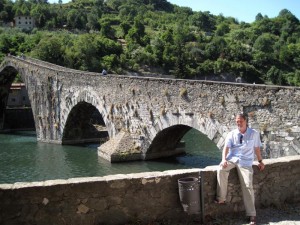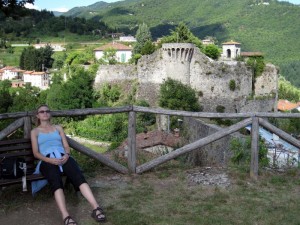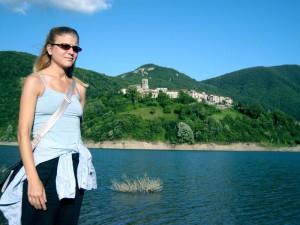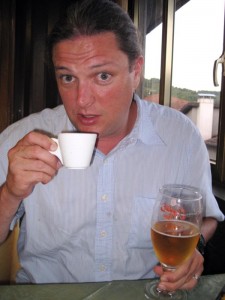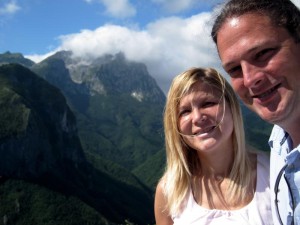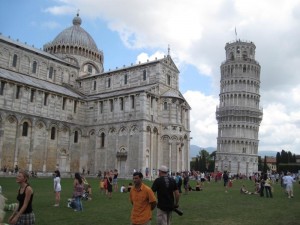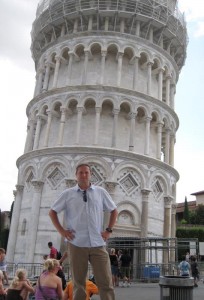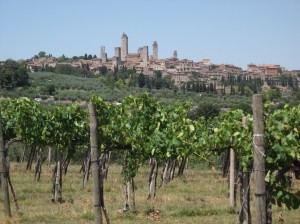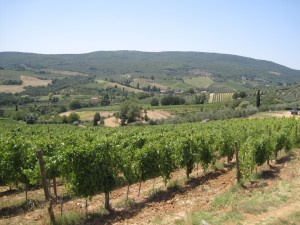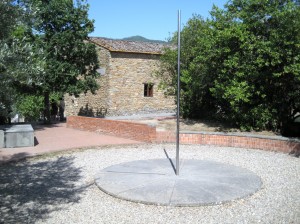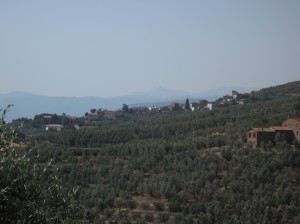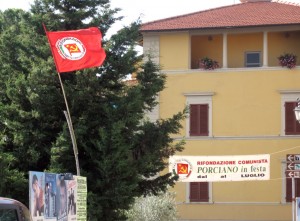We were due back in Rome in a few days after returning from Grado, and other than the roads, we hadn’t seen much of the Garfagnana region. The next morning, we headed down the main road of the region, along the river, heading south toward Lucca. Along the way, we came across this cool old medieval bridge, the Ponte della Maddelena (or sometimes called the Ponte del Diavolo – the Devil’s Bridge).
It was very steep in the middle and more than 900 years old, but as amazing as that is, I found it more strange that the hundreds of motorcycles moving on the roads on either side of the river didn’t want to cruise up and over the bridge. After all, there were no stairs to block them. I guess the few tourists taking pictures at the top of the bridge really put them off of that idea.
We wandered through several of the larger and smaller towns of the region, including Castiglione di Garfagnana, where Katherine took a quick rest in a very beautiful spot.
One of the wonderful things about the Garfagnana region is that you can really get far, far away from the major roads and enjoy nature with Italians doing the same thing. During one of our loops off of the main road, we drove beside the Lago di Vagli, which features a picturesque town toward the middle of the lake, which was formed by a dam and has an abandoned village at the bottom of it that you can actually visit every few years, when they drain the lake.
All along the way, I made sure to keep myself caffinated. But all of those uppers required some downers for, well, you know, equilibrium, so you have to balance it out with a beer or a glass of wine. The risk, though, of course, is that you can look like this at the end of the day.
Rather than zooming directly back to Rome via the autostradas, we headed west over the mountains and were able to see many of the famous mountains that contain some of the world’s finest marble. And the scenery wasn’t half-bad either…
We emerged from the mountains near the sea and headed south to a very crowded Pisa. The leaning tower was the major draw, as you might expect, but the tourists were almost a sight to see by themselves, disgourging from buses and bumbling through ramshackle street shops, wandering into the light and expressing their wonder at the sights in front of them by acting like they were holding up the tower for hundreds of photos taken per minute. I mean, there was literally a line of people waiting to get the correct perspective to make the same optical illusion joke as the person directly in front of them.
Oh well, the duomo and the tower are very beautiful and worth experiencing close up.
And that lean is very real. I really didn’t expect to really worry about the structural integrity of the tower, but even with the actions they’ve recently taken to preserve the tower – like taking out the marble columns on the downward side and replacing them with lighter materials – I’m not sure I would want to go up there. And the waiting line of tourists and high admission price settled it.
Before the Romans dominated the peninsula, Etruscans ruled the roost. We swung into the Tuscan southern highlands and explored a few ancient towns founded by Etruscans among an area of hot springs. We also explored a small island connected to the mainland by a small spit of sand and a bridge. Porto Ercole really looked like an interesting place, but we were running out of light.
We didn’t actually make it Rome that night, but we did find a decent pension 30k north of Rome, along the sea.
